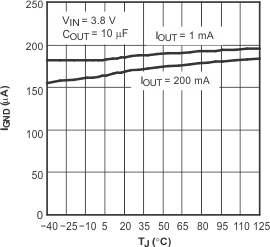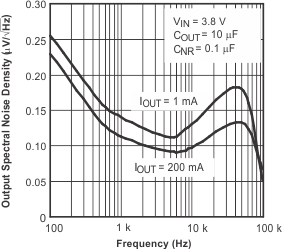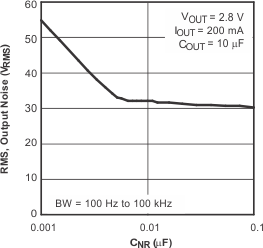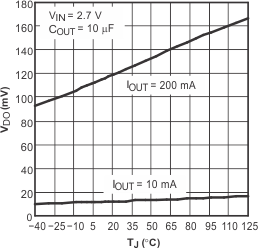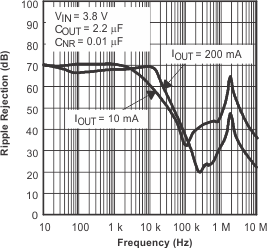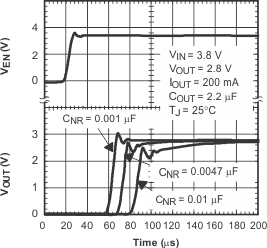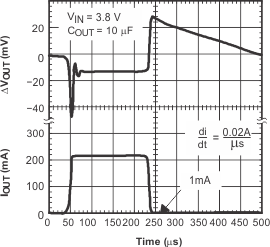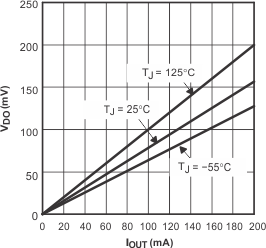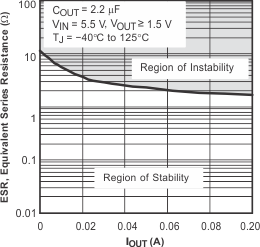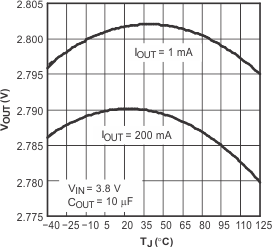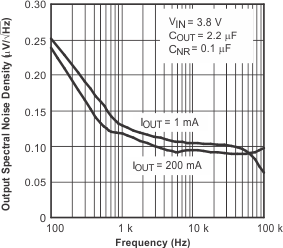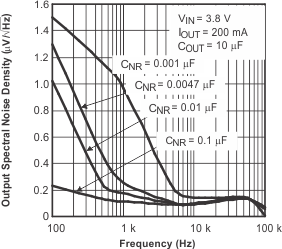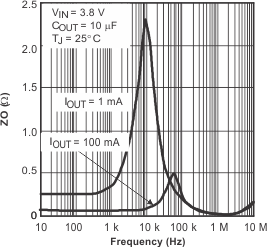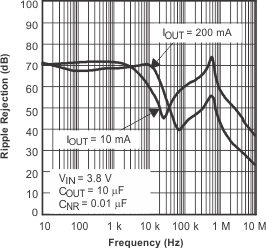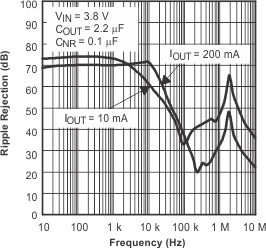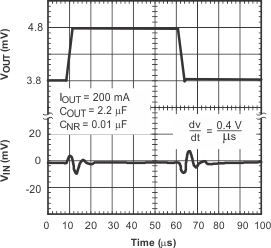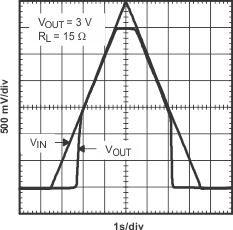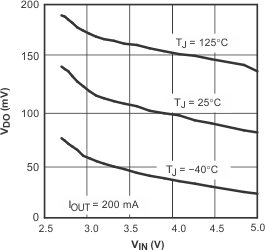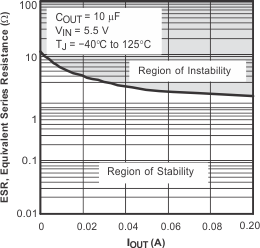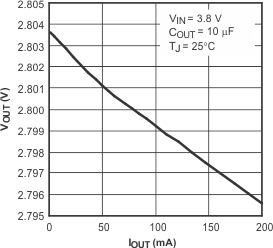SLVS348L July 2001 – May 2015 TPS793
PRODUCTION DATA.
- 1 Features
- 2 Applications
- 3 Description
- 4 Revision History
- 5 Pin Configuration and Functions
- 6 Specifications
- 7 Detailed Description
- 8 Application and Implementation
- 9 Power Supply Recommendations
- 10Layout
- 11Device and Documentation Support
- 12Mechanical, Packaging, and Orderable Information
6 Specifications
6.1 Absolute Maximum Ratings
over operating junction temperature range (unless otherwise noted). All voltages are with respect to GND.(1)| MIN | MAX | UNIT | |||
|---|---|---|---|---|---|
| Voltage | Input, VIN | –0.3 | 6 | V | |
| Enable, VEN | –0.3 | 6 | V | ||
| Output, VOUT | –0.3 | 6 | V | ||
| Current | Peak output, IOUT(max) | Internally limited | A | ||
| Output short-circuit duration | Indefinite | ||||
| Total power dissipation | Continuous, PD(tot) | See Thermal Information | |||
| Temperature | Junction, TJ | DBV package | –40 | 150 | °C |
| YZQ package | –40 | 125 | °C | ||
| Storage, Tstg | –65 | 150 | °C | ||
(1) Stresses beyond those listed under Absolute Maximum Ratings may cause permanent damage to the device. These are stress ratings only, which do not imply functional operation of the device at these or any other conditions beyond those indicated under Recommended Operating Conditions. Exposure to absolute-maximum-rated conditions for extended periods may affect device reliability.
6.2 ESD Ratings
| VALUE | UNIT | |||
|---|---|---|---|---|
| V(ESD) | Electrostatic discharge | Human body model (HBM), per ANSI/ESDA/JEDEC JS-001, all pins(1) | ±2000 | V |
| Charged device model (CDM), per JEDEC specification JESD22-C101, all pins(2) | ±500 | |||
(1) JEDEC document JEP155 states that 500-V HBM allows safe manufacturing with a standard ESD control process.
(2) JEDEC document JEP157 states that 250-V CDM allows safe manufacturing with a standard ESD control process.
6.3 Recommended Operating Conditions
over operating junction temperature range (unless otherwise noted).| MIN | NOM | MAX | UNIT | ||
|---|---|---|---|---|---|
| VIN | Input supply voltage range | 2.7 | 5.5 | V | |
| VEN | Enable supply voltage range | 0 | VIN | V | |
| VOUT | Output voltage range | VFB | 5 | V | |
| IOUT | Output current | 0 | 200 | mA | |
| TJ | Operating junction temperature | –40 | 125 | °C | |
| CIN | Input capacitor | 0.1 | 1 | µF | |
| COUT | Output capacitor | 2.2(1) | 10 | µF | |
| CNR | Noise reduction capacitor | 0 | 10 | nF | |
| CFF | Feed-forward capacitor | 15 | pF | ||
| R2 | Lower feedback resistor | 30.1 | kΩ | ||
(1) If CFF is not used or VOUT(nom) < 1.8 V, the minimum recommended COUT = 4.7 µF.
6.4 Thermal Information
| THERMAL METRIC(1) | TPS79301 | UNIT | ||
|---|---|---|---|---|
| DBV (SOT-23) | YZQ (DSBGA) | |||
| 6 PINS | 5 PINS | |||
| RθJA | Junction-to-ambient thermal resistance | 225.1 | 178.5 | °C/W |
| RθJC(top) | Junction-to-case (top) thermal resistance | 78.4 | 1.4 | °C/W |
| RθJB | Junction-to-board thermal resistance | 54.7 | 62.1 | °C/W |
| ψJT | Junction-to-top characterization parameter | 3.3 | 0.9 | °C/W |
| ψJB | Junction-to-board characterization parameter | 53.8 | 62.1 | °C/W |
(1) For more information about traditional and new thermal metrics, see the Semiconductor and IC Package Thermal Metrics application report, SPRA953.
6.5 Electrical Characteristics
Over recommended operating temperature range TJ = –40°C to 125°C, VEN = VIN, VIN = VOUT(nom) + 1 V(1), IOUT = 1 mA, COUT = 10 μF, CNR = 0.01 μF (unless otherwise noted). Typical values are at TJ = 25°C.| PARAMETER | TEST CONDITIONS | MIN | TYP | MAX | UNIT | |||
|---|---|---|---|---|---|---|---|---|
| VIN | Input voltage range(1) | 2.7 | 5.5 | V | ||||
| IOUT | Continuous output current | 0 | 200 | mA | ||||
| VFB | Internal reference (TPS79301) | 1.201 | 1.225 | 1.250 | V | |||
| VOUT | Output voltage range | TPS79301 | VFB | 5.5 – VDO | V | |||
| TPS79318 | 0 µA < IOUT < 200 mA, 2.8 V < VIN < 5.5 V | 1.764 | 1.8 | 1.836 | ||||
| TPS79325 | 0 µA < IOUT < 200 mA, 3.5 V < VIN < 5.5 V | 2.45 | 2.5 | 2.55 | ||||
| TPS79328 | 0 µA < IOUT < 200 mA, 3.8 V < VIN < 5.5 V | 2.744 | 2.8 | 2.856 | ||||
| TPS793285 | 0 µA < IOUT < 200 mA, 3.85 V < VIN < 5.5 V | 2.793 | 2.85 | 2.907 | ||||
| TPS79330 | 0 µA < IOUT < 200 mA, 4 V < VIN < 5.5 V | 2.94 | 3 | 3.06 | ||||
| TPS79333 | 0 µA < IOUT < 200 mA, 4.3 V < VIN < 5.5 V | 3.234 | 3.3 | 3.366 | ||||
| TPS793475 | 0 µA < IOUT < 200 mA, 5.25 V < VIN < 5.5 V | 4.655 | 4.75 | 4.845 | ||||
| ΔVOUT(ΔVIN) | Line regulation | VOUT + 1 V < VIN ≤ 5.5 V | 0.05 | 0.12 | %/V | |||
| ΔVOUT(ΔIOUT) | Load regulation | 0 µA < IOUT < 200 mA, TJ = 25°C | 5 | mV | ||||
| VDO | Dropout voltage(2)
(VIN = VOUT(nom) – 0.1 V) |
TPS79328 | IOUT = 200 mA | 120 | 200 | mV | ||
| TPS793285 | IOUT = 200 mA | 120 | 200 | |||||
| TPS79330 | IOUT = 200 mA | 112 | 200 | |||||
| TPS79333 | IOUT = 200 mA | 12 | 180 | |||||
| TPS793475 | IOUT = 200 mA | 77 | 125 | |||||
| ICL | Output current limit | VOUT = 0 V | 285 | 600 | mA | |||
| IGND | Ground pin current | 0 µA < IOUT < 200 mA | 170 | 220 | µA | |||
| ISHUTDOWN | Shutdown current(3) | VEN = 0 V, 2.7 V < VIN < 5.5 V | 0.07 | 1 | µA | |||
| IFB | FB pin current | VFB = 1.8 V | 1 | µA | ||||
| PSRR | Power-supply rejection ratio | TPS79328 | f = 100 Hz, IOUT = 10 mA | 70 | dB | |||
| f = 100 Hz, IOUT = 200 mA | 68 | |||||||
| f = 10 kHz, IOUT = 200 mA | 70 | |||||||
| f = 100 kHz, IOUT = 200 mA | 43 | |||||||
| Vn | Output noise voltage | TPS79328 | BW = 200 Hz to 100 kHz, IOUT = 200 mA |
CNR = 0.001 μF | 55 | µVRMS | ||
| CNR = 0.0047 μF | 36 | |||||||
| CNR = 0.01 μF | 33 | |||||||
| CNR = 0.1 μF | 32 | |||||||
| tSTR | Startup time | TPS79328 | RL = 14 Ω, COUT = 1 µF |
CNR = 0.001 μF | 50 | µs | ||
| CNR = 0.0047 μF | 70 | |||||||
| CNR = 0.01 μF | 100 | |||||||
| VEN(high) | High-level enable input voltage | 2.7 V < VIN < 5.5 V | 1.7 | VIN | V | |||
| VEN(low) | Low-level enable input voltage | 2.7 V < VIN < 5.5 V | 0 | 0.7 | V | |||
| IEN | EN pin current | VEN = 0 V | –1 | 1 | µA | |||
| UVLO | Threshold, VCC rising | 2.25 | 2.65 | V | ||||
| Hysteresis | 100 | mV | ||||||
(1) Minimum VIN is 2.7 V or VOUT + VDO, whichever is greater.
(2) Dropout is not measured for the TPS79318 and TPS79325 because minimum VIN = 2.7 V.
(3) For adjustable versions, this parameter applies only after VIN is applied; then VEN transitions high to low.
6.6 Typical Characteristics
Over recommended operating temperature range TJ = –40°C to 125°C, VEN = VIN, VIN = VOUT(nom) + 1 V, IOUT = 1 mA, COUT = 10 μF, CNR = 0.01 μF, VOUT(nom) = 2.8 V (unless otherwise noted). Typical values are at TJ = 25°C.